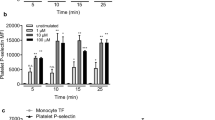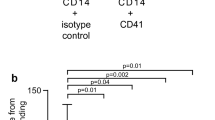Abstract
Monocytes contribute to the development of atherosclerotic lesions in mouse models1,3. The chemoattractant proteins (chemokines), monocyte chemoattractant protein-1 (MCP-1) and interleukin-8 (IL-8), are found in human atheroma4,5, and mice lacking receptors for these chemokines are less susceptible to atherosclerosis and have fewer monocytes in vascular lesions6,7. Although MCP-1 has a powerful effect on monocytes, IL-8 is thought to act predominantly on neutrophils and it is unclear howit could recruit monocytes6,8. Here we investigate the ability of chemokines to control the interaction of monocytes under flow conditions with vascular endothelium that has been transduced to express specific leukocyte-adherence receptors. We find that MCP-1 and IL-8 can each rapidly cause rolling monocytes to adhere firmly onto monolayers expressing E-selectin, whereas related chemokines do not. These effects do not correlate with either the induction of a calcium transient or chemotaxis. We conclude that chemokines are important modulators of monocyte–endothelial interactions under flow conditions. Moreover, our finding that IL-8 is a powerful trigger for firm adhesion of monocytes to vascular endothelium reveals an unexpected role for this chemokine in monocyte recruitment.
This is a preview of subscription content, access via your institution
Access options
Subscribe to this journal
Receive 51 print issues and online access
$199.00 per year
only $3.90 per issue
Buy this article
- Purchase on Springer Link
- Instant access to full article PDF
Prices may be subject to local taxes which are calculated during checkout






Similar content being viewed by others
References
Smith, J. D. et al. Decreased atherosclerosis in mice deficient in both macrophage colony-stimulating factor (op) and apolipoprotein E. Proc. Natl Acad. Sci. USA 92, 8264–8268 (1995).
Suzuki, H. et al. Arole for macrophage scavenger receptors in atherosclerosis and susceptibility to infection. Nature 386, 292–296 (1997).
Fazio, S. et al. Increased atherosclerosis in mice reconstituted with apolipoprotein E null macrophages. Proc. Natl Acad. Sci. USA 94, 4647–4652 (1997).
Nelken, N. A., Coughlin, S. R., Gordon, D. & Wilcox, J. N. Monocyte chemoattractant protein-1 in human atheromatous plaques. J. Clin. Invest. 88, 1121–1127 (1991).
Koch, A. E. et al. Enhanced production of the chemotactic cytokines interleukin-8 and monocyte chemoattractant protein-1 in human abdominal aortic aneurysms. Am. J. Pathol. 142, 1423–1431 (1993).
Boisvert, W. A., Santiago, R., Curtiss, L. K. & Terkeltaub, R. A. Aleukocyte homologue of the IL-8 receptor CXCR-2 mediates the accumulation of macrophages in atherosclerotic lesions of LDL receptor-deficient mice. J. Clin. Invest. 101, 353–363 (1998).
Boring, L., Goslin, J., Cleary, M. & Charo, I. Decreased lesion formation in CCR2−/− mice reveals a role for chemokines in the initiation of atherosclerosis. Nature 394, 894–897 (1998).
Baggiolini, M., Dewald, B. & Moser, B. Interleukin-8 and related chemokines — CXC and CC chemokines. Adv. Immunol. 55, 97–179 (1994).
Gerszten, R. E. et al. Adhesion of monocytes to vascular cell adhesion molecule-1-transduced human endothelial cells: implications for atherogenesis. Circ. Res. 82, 871–878 (1998).
Berkhout, T. A. et al. Cloning, in vitro expression, and functional characterization of a novel human CC chemokine of the monocyte chemoattractant protein (MCP) family that binds and signals through the CC chemokine receptor 2B. J. Biol. Chem. 272, 16404–16413 (1997).
Springer, T. A. Traffic signals for lymphocyte recirculation and leukocyte emigration: the multistep paradigm. Cell 76, 301–314 (1994).
Weber, C., Alon, R., Moser, B. & Springer, T. A. Sequential regulation of alpha 4 beta 1 and alpha 5 beta 1 integrin avidity by CC chemokines in monocytes: implications for transendothelial chemotaxis. J.Cell Biol. 134, 1063–1073 (1996).
Woldemar-Carr, M., Alon, R. & Springer, T. A. The C-C chemokine MCP-1 differentially modulates the avidity of β1 and β2 integrins on T lymphocytes. Immunity 4, 179–187 (1996).
Yoshimura, T. et al. Purification of a human monocyte-derived neutrophil chemotactic factor that has peptide sequence similarity to other host defense cytokines. Proc. Natl Acad. Sci. USA 84, 9233–9237 (1987).
Schroder, J. M., Mrowietz, U., Morita, E. & Christophers, E. Purification and partial biochemical characterization of a human monocyte-derived, neutrophil-activating peptide that lacks interleukin 1 activity. J. Immunol. 139, 3474–3483 (1987).
Chuntharapai, A., Lee, J., Hebert, C. A. & Kim, K. J. Monoclonal antibodies detect different distribution patterns of IL-8 receptor A and IL-8 receptor B on human peripheral blood leukocytes. J. Immunol. 153, 5682–5688 (1994).
Premack, B. A. & Schall, T. J. Chemokine receptors: gateways to inflammation and infection. Nat. Med. 2, 1174–1178 (1996).
Jones, K. A. et al. GABA(B) receptors function as a heteromeric assembly of the subunits GABA(B)R1 and GABA(B)R2. Nature 396, 674–679 (1998).
Luscinskas, F. W. et al. Monocyte rolling, arrest and spreading on IL-4-activated vascular endothelium under flow is mediated via sequential action of L-selectin, beta 1-integrins, and beta 2-integrins. J. Cell Biol. 125, 1417–1427 (1994).
Gerszten, R. et al. Adhesion of memory lymphocytes to VCAM-1-transduced human vascular endothelial cells under simulated physiological flow conditions in vitro. Circ. Res. 79, 1205–1215 (1996).
Yoshida, M., Szente, B. E., Kiely, J.-M., Rosenzweig, A. & Gimbrone, M. A. Regulation of E-selectin phosphorylation during leukocyte adhesion: a novel outside-in signaling role for E-selectin. J.Immunol. 161, 933–941 (1997).
Graber, N. et al. Tcells bind to cytokine-activated endothelial cells via a novel, inducible sialoglycoprotein and endothelial leukocyte adhesion molecule-1. J. Immunol. 145, 819–830 (1990).
Bevilacqua, M. P., Prober, J. S., Mendrick, D. L., Cotran, R. S. & Gimbrone, M. A. Identification of an inducible endothelial-leukocyte adhesion molecule. Proc. Natl Acad. Sci. USA 84, 9238–9242 (1987).
Luscinskas, F. W. et al. Cytokine-activated human endothelial monolayers support enhanced neutrophil transmigration via a mechanism involving both endothelial-leukocyte adhesion molecule-1 and intercellular adhesion molecule-1. J. Immunol. 146, 1617–1625 (1991).
Taichman, D. B. et al. Tumor cell surface alpha 4 beta 1 integrin mediates adhesion to vascular endothelium: demonstration of an interaction with the N-terminal domains of INCAM-110/VCAM-1. Cell Regul. 2, 347–355 (1991).
Luscinskas, F. W. et al. L- and P-selectins, but not CD49d (VLA4) integrins, mediate monocyte initial attachment to TNF-activated vascular endothelium in vitro. J. Immunol. 156, 326–335 (1996).
Shen, J., Luscinskas, F. W., Connolly, A., Dewey, C. F. J. & Gimbrone, M. A. Fluid shear stress modulates cytosolic free calcium in vascular endothelial cells. Am. J. Physiol. 262, C384–390 (1992).
Wheeler, M. E., Luscinskas, F. W., Bevilacqua, M. P. & Gimbrone, M. A. Cultured human endothelial cells stimulated with cytokines or endotoxin produce an inhibitor of leukocyte adhesion. J. Clin. Invest. 82, 1211–1218 (1988).
Falk, W., Goodwin, R. H. J & Leonard, E. J. A48-well micro chemotaxis assembly for rapid and accurate measurement of leukocyte migration. J. Immunol. Meth. 33, 239–247 (1980).
Acknowledgements
We thank K. Case and W. Atkinson for preparation of human endothelial cell cultures; L. Li and Q. Qui for technical assistance; P. Kaltofen for help with manuscript preparation; M.Cybulsky for rabbit VCAM-1 cDNA and antibody Rb1/9; D. Dichek for help in construction of AdVCAM-1 and for AdRSV β-gal; Leukosite for antibody 2D7; I. Charo for reviewing the manuscript; Z.N. Demirjian and other members of the MGH Clinical Hematology Laboratory for their review of leukocyte morphology. We acknowledge support from the NIH (R.E.G., A.R., M.A.G., F.W.L., A.D.L.). A.R. is an Established Investigator of the American Heart Association.
Author information
Authors and Affiliations
Corresponding author
Rights and permissions
About this article
Cite this article
Gerszten, R., Garcia-Zepeda, E., Lim, YC. et al. MCP-1 and IL-8 trigger firm adhesion of monocytes to vascular endothelium under flow conditions. Nature 398, 718–723 (1999). https://doi.org/10.1038/19546
Received:
Accepted:
Issue Date:
DOI: https://doi.org/10.1038/19546
This article is cited by
-
Monocyte, neutrophil, and whole blood transcriptome dynamics following ischemic stroke
BMC Medicine (2023)
-
The mechanism and therapy of aortic aneurysms
Signal Transduction and Targeted Therapy (2023)
-
EGFR activation differentially affects the inflammatory profiles of female human aortic and coronary artery endothelial cells
Scientific Reports (2023)
-
Bone marrow mesenchymal stem cells’ osteogenic potential: superiority or non-superiority to other sources of mesenchymal stem cells?
Cell and Tissue Banking (2023)
-
Mechanisms of Arsenic Exposure-Induced Hypertension and Atherosclerosis: an Updated Overview
Biological Trace Element Research (2023)
Comments
By submitting a comment you agree to abide by our Terms and Community Guidelines. If you find something abusive or that does not comply with our terms or guidelines please flag it as inappropriate.



